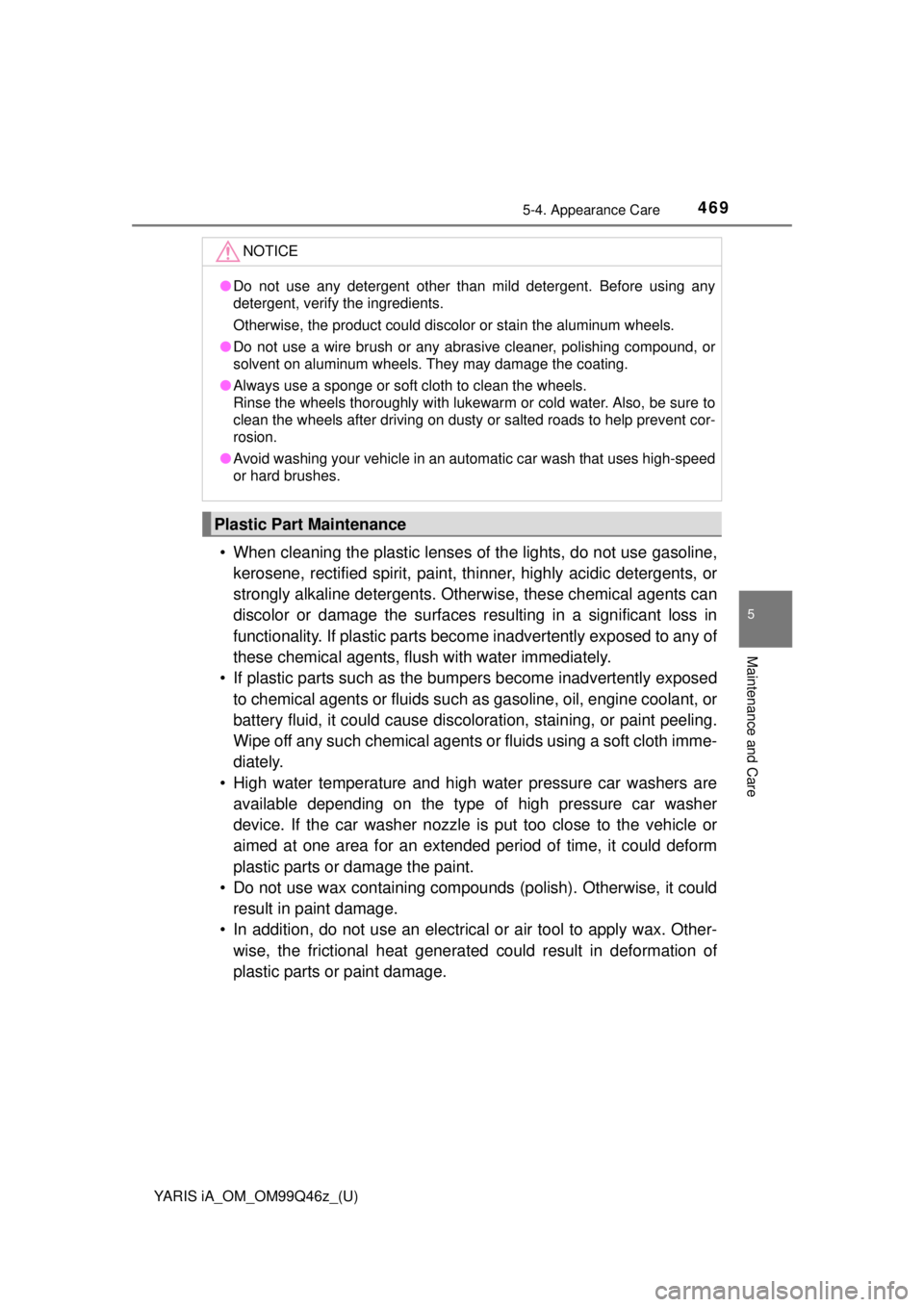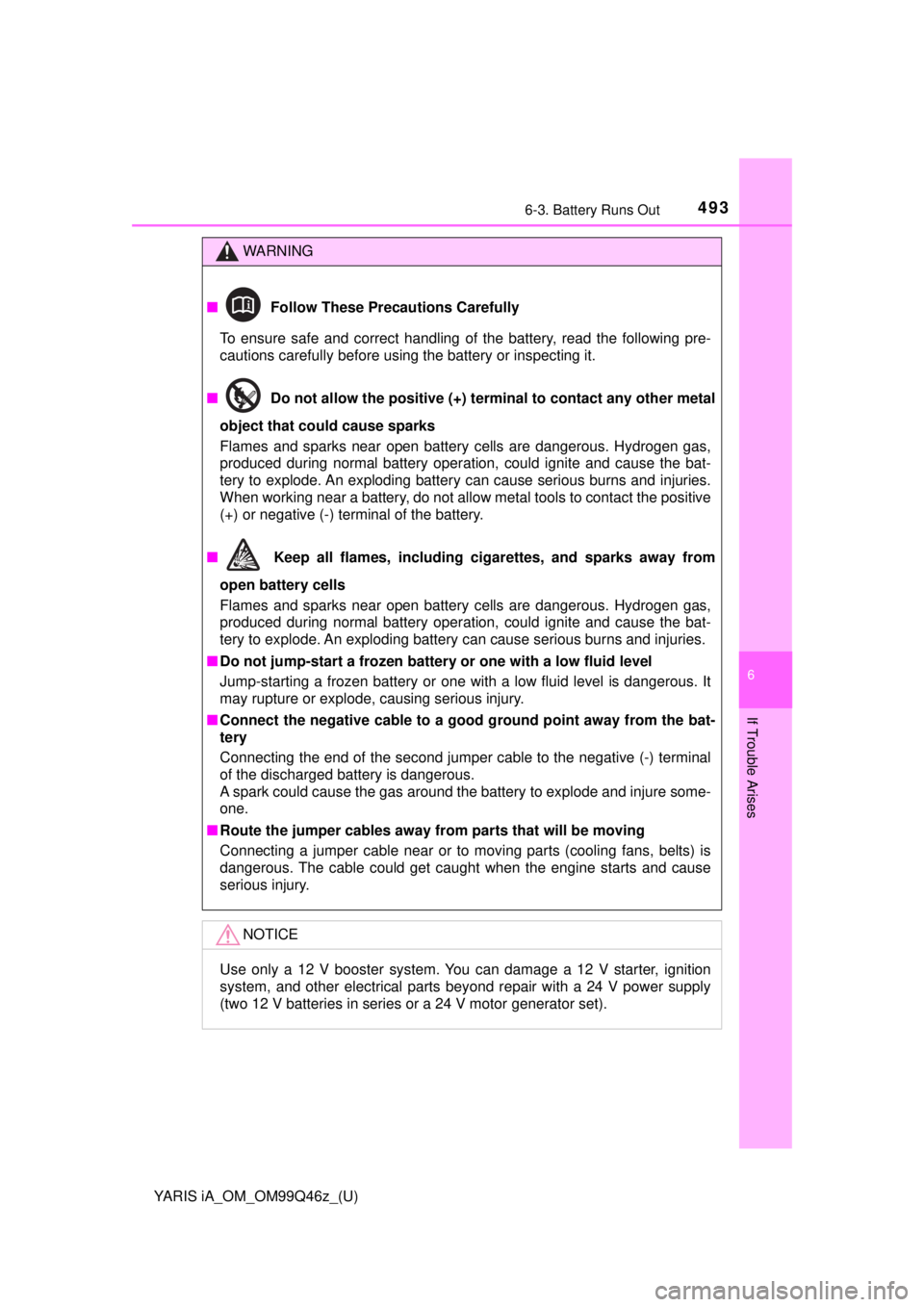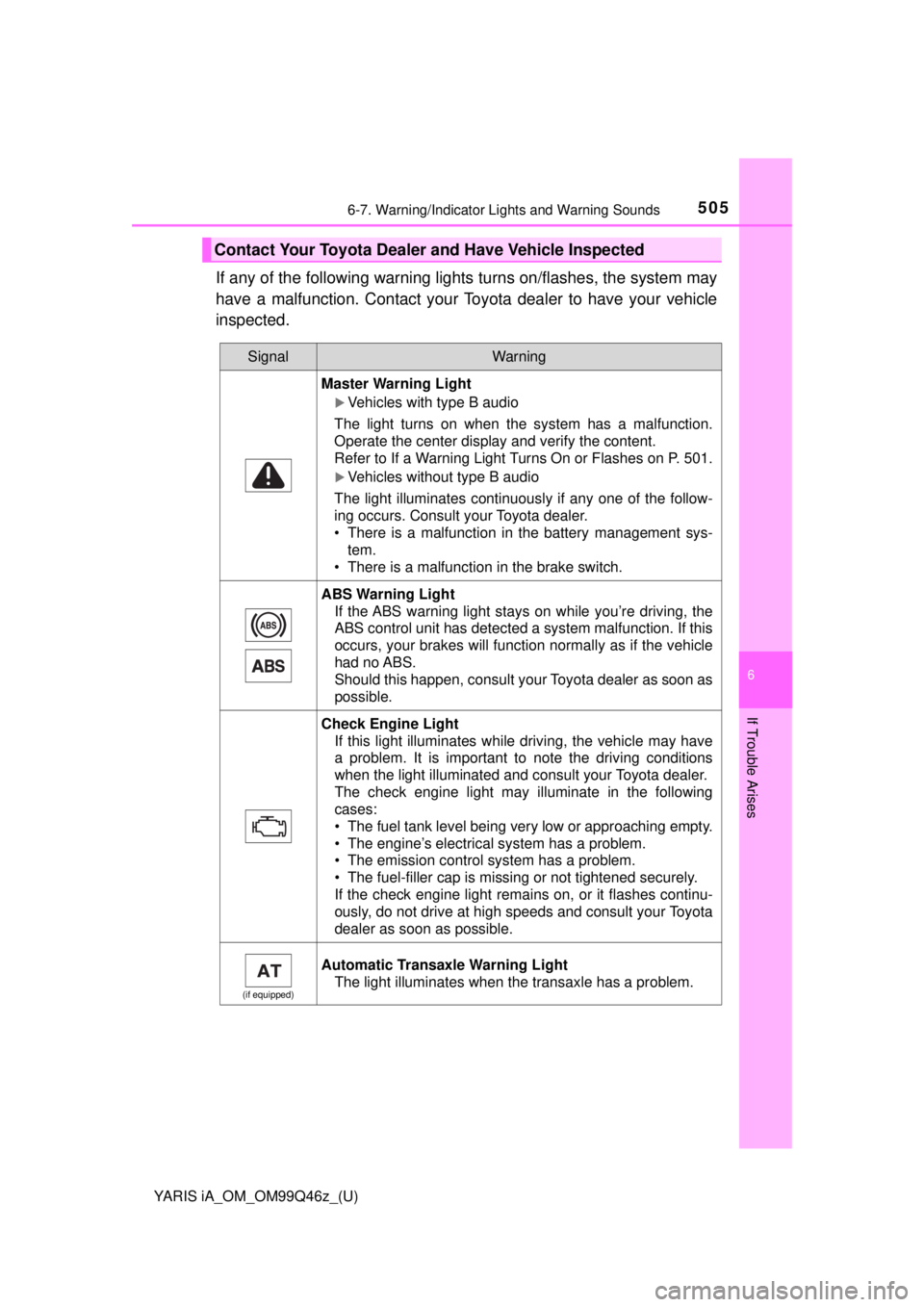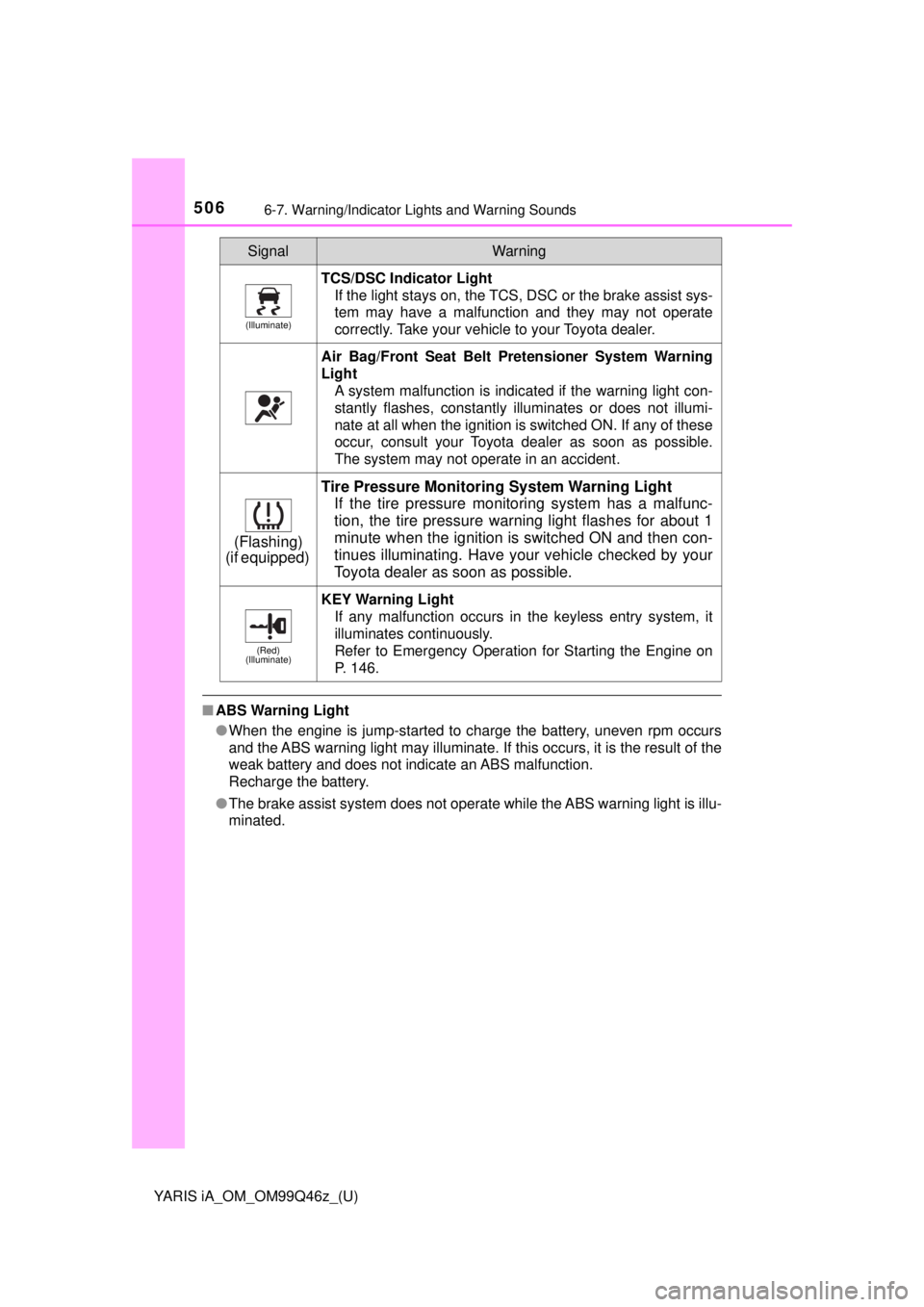Page 469 of 576

YARIS iA_OM_OM99Q46z_(U)
4695-4. Appearance Care
5
Maintenance and Care
• When cleaning the plastic lenses of the lights, do not use gasoline,
kerosene, rectified spirit , paint, thinner, highly acidic detergents, or
strongly alkaline detergents. Other wise, these chemical agents can
discolor or damage the surfaces resulting in a significant loss in
functionality. If plastic parts beco me inadvertently exposed to any of
these chemical age nts, flush with water immediately.
• If plastic parts such as the bu mpers become inadvertently exposed
to chemical agents or fluids such as gasoline, oil, engine coolant, or
battery fluid, it could cause discoloration, stai ning, or paint peeling.
Wipe off any such chemical agents or fluids using a soft cloth imme-
diately.
• High water temperature and high water pressure car washers are available depending on the type of high pressure car washer
device. If the car washer nozzle is put too close to the vehicle or
aimed at one area for an extended period of time, it could deform
plastic parts or damage the paint.
• Do not use wax containing compounds (polish). Otherwise, it could
result in paint damage.
• In addition, do not use an electrical or air tool to apply wax. Other-
wise, the frictional heat generat ed could result in deformation of
plastic parts or paint damage.
NOTICE
● Do not use any detergent other than mild detergent. Before using any
detergent, verify the ingredients.
Otherwise, the product could discolor or stain the aluminum wheels.
● Do not use a wire brush or any abrasive cleaner, polishing compound, or
solvent on aluminum wheels. They may damage the coating.
● Always use a sponge or soft cloth to clean the wheels.
Rinse the wheels thoroughly with lukewarm or cold water. Also, be sure to
clean the wheels after driving on dusty or salted roads to help prevent cor-
rosion.
● Avoid washing your vehicle in an automatic car wash that uses high-speed
or hard brushes.
Plastic Part Maintenance
Page 475 of 576
475
YARIS iA_OM_OM99Q46z_(U)
6If Trouble Arises
6-1. Parking in an EmergencyParking in an Emergency ...................... 476
6-2. Flat Tire Spare Tire and Tool Storage ........................... 477
Changing a Flat Tire ......... 481
6-3. Battery Runs Out Jump-Starting.................... 491
6-4. Emergency Starting Starting a Flooded Engine............................. 494
Push-Starting .................... 495
6-5. Overheating Overheating ...................... 496
6-6. Emergency Towing Towing Description ........... 498
Tiedown Hooks ................. 499
6-7. Warning/Indicator Lights and Warning Sounds
If a Warning Light Turns On or Flashes ................. 501
Message Indicated on Display ............................ 512
Warning Sound is Activated ......................... 514
6-8. When Trunk Lid Cannot be Opened
When Trunk Lid Cannot be Opened ...................... 517
Page 491 of 576
491
YARIS iA_OM_OM99Q46z_(U)
6-3. Battery Runs Out
6
If Trouble Arises
Jump-Starting
Jump-starting is dangerous if done incorrectly. So follow the proce-
dure carefully. If you feel unsure about jump-starting, we strongly rec-
ommend that you have a competent service technician do the work.Remove the battery cover.
Make sure the booster battery is 12 V and that its negative terminal
is grounded.
If the booster battery is in another vehicle, do not allow both vehi-
cles to touch. Turn off the engine of the vehicle with the booster bat-
tery and all unnecessary electrical loads in both vehicles.
1
2
3
Page 492 of 576
4926-3. Battery Runs Out
YARIS iA_OM_OM99Q46z_(U)
Connect the jumper cables in the exact sequence as in the illustra-
tion.
Connect one end of a cable to the positive terminal on the dis-
charged battery.
Attach the other end to the positive terminal on the booster bat-
tery.
Connect one end of the other cabl e to the negative terminal of
the booster battery.
Connect the other end to the ground point indicated in the illus-
tration away from the discharged battery.
Start the engine of the booster v ehicle and run it a few minutes.
Then start the engine of the other vehicle.
When finished, carefully disconnect the cables in the reverse order
described in the illustration.
If the battery cover has been removed, install it in the reverse order
of removal.
Verify that the covers are securely installed.
4
Jumper cables
Booster battery
Discharged battery
1
2
3
4
5
6
7
Page 493 of 576

YARIS iA_OM_OM99Q46z_(U)
4936-3. Battery Runs Out
6
If Trouble Arises
WARNING
■ Follow These Precautions Carefully
To ensure safe and correct handling of the battery, read the following pre-
cautions carefully before using the battery or inspecting it.
■ Do not allow the positive (+) term inal to contact any other metal
object that could cause sparks
Flames and sparks near open battery cells are dangerous. Hydrogen gas,
produced during normal battery operation, could ignite and cause the bat-
tery to explode. An exploding battery can cause serious burns and injuries.
When working near a battery, do not allow metal tools to contact the positive
(+) or negative (-) terminal of the battery.
■ Keep all flames, including cigarettes, and sparks away from
open battery cells
Flames and sparks near open battery cells are dangerous. Hydrogen gas,
produced during normal battery operation, could ignite and cause the bat-
tery to explode. An exploding battery can cause serious burns and injuries.
■ Do not jump-start a frozen battery or one with a low fluid level
Jump-starting a frozen battery or one with a low fluid level is dangerous. It
may rupture or explode, causing serious injury.
■ Connect the negative cable to a good ground point away from the bat-
tery
Connecting the end of the second jumper cable to the negative (-) terminal
of the discharged battery is dangerous.
A spark could cause the gas around the battery to explode and injure some-
one.
■ Route the jumper cables away fr om parts that will be moving
Connecting a jumper cable near or to moving parts (cooling fans, belts) is
dangerous. The cable could get caught when the engine starts and cause
serious injury.
NOTICE
Use only a 12 V booster system. You can damage a 12 V starter, ignition
system, and other electrical parts beyond repair with a 24 V power supply
(two 12 V batteries in series or a 24 V motor generator set).
Page 505 of 576

YARIS iA_OM_OM99Q46z_(U)
5056-7. Warning/Indicator Lights and Warning Sounds
6
If Trouble Arises
If any of the following warning lights turns on/flashes, the system may
have a malfunction. Contact your Toyota dealer to have your vehicle
inspected.
Contact Your Toyota Dealer and Have Vehicle Inspected
SignalWarning
Master Warning Light
Vehicles with type B audio
The light turns on when the system has a malfunction.
Operate the center display and verify the content.
Refer to If a Warning Light Turns On or Flashes on P. 501.
Vehicles without type B audio
The light illuminates continuously if any one of the follow-
ing occurs. Consult your Toyota dealer.
• There is a malfunction in the battery management sys- tem.
• There is a malfunction in the brake switch.
ABS Warning Light If the ABS warning light stays on while you’re driving, the
ABS control unit has detected a system malfunction. If this
occurs, your brakes will function normally as if the vehicle
had no ABS.
Should this happen, consult your Toyota dealer as soon as
possible.
Check Engine LightIf this light illuminates while driving, the vehicle may have
a problem. It is important to note the driving conditions
when the light illuminated and consult your Toyota dealer.
The check engine light may illuminate in the following
cases:
• The fuel tank level being very low or approaching empty.
• The engine’s electrical system has a problem.
• The emission control system has a problem.
• The fuel-filler cap is missing or not tightened securely.
If the check engine light remains on, or it flashes continu-
ously, do not drive at high speeds and consult your Toyota
dealer as soon as possible.
(if equipped)
Automatic Transaxle Warning LightThe light illuminates when the transaxle has a problem.
Page 506 of 576

5066-7. Warning/Indicator Lights and Warning Sounds
YARIS iA_OM_OM99Q46z_(U)
■ABS Warning Light
●When the engine is jump-started to charge the battery, uneven rpm occurs
and the ABS warning light may illuminate. If this occurs, it is the result of the
weak battery and does not indicate an ABS malfunction.
Recharge the battery.
● The brake assist system does not operate while the ABS warning light is illu-
minated.
(Illuminate)
TCS/DSC Indicator Light
If the light stays on, the TCS, DSC or the brake assist sys-
tem may have a malfunction and they may not operate
correctly. Take your vehicle to your Toyota dealer.
Air Bag/Front Seat Belt Pretensioner System Warning
LightA system malfunction is indicated if the warning light con-
stantly flashes, constantly illuminates or does not illumi-
nate at all when the ignition is switched ON. If any of these
occur, consult your Toyota dealer as soon as possible.
The system may not operate in an accident.
(Flashing)
(if equipped)
Tire Pressure Monitoring System Warning Light
If the tire pressure monitoring system has a malfunc-
tion, the tire pressure warn ing light flashes for about 1
minute when the ignition is switched ON and then con-
tinues illuminating. Have your vehicle checked by your
Toyota dealer as soon as possible.
(Red)
(Illuminate)
KEY Warning Light
If any malfunction occurs in the keyless entry system, it
illuminates continuously.
Refer to Emergency Operation for Starting the Engine on
P. 146.
SignalWarning
Page 510 of 576

5106-7. Warning/Indicator Lights and Warning Sounds
YARIS iA_OM_OM99Q46z_(U)■
KEY Warning Light
Take the appropriate action and veri
fy that the warning light turns
off.
■ Low Fuel Warning Light
The light illumination timing may vary because fuel inside the fuel tank moves
around according to the driving conditions and the vehicle posture.
■ Seat Belt Warning Light
●The warning light flashes for about 6 seconds if the driver’s seat belt is not
fastened when the ignition is switched ON.
● To allow the front passenger occupant classification sensor to function p\
rop-
erly, do not place and sit on an additional seat cushion on the front passen-
ger’s seat. The sensor may not function properly because the additional
seat cushion could cause sensor interference.
● If a small child is seated on the front passenger’s seat, the warning light may
not operate.
SignalCauseAction to be taken
(Red)
(Flashing)
The smart key battery is dead.Replace the key battery
( →P. 436).
The smart key is not within the
operation range.
Bring the smart key into
the operation range
(→P. 93).The smart key is placed in
areas inside the cabin where it
is difficult for the key to be
detected.
A key from another manufac-
turer similar to the smart key is
in the operation range.Take the key from another
manufacturer similar to
the smart key out of the
operation range.
Without the ignition switched
off, the smart key is taken out of
the cabin, and then all the
doors are closed.
Bring the smart key back
into the cabin.